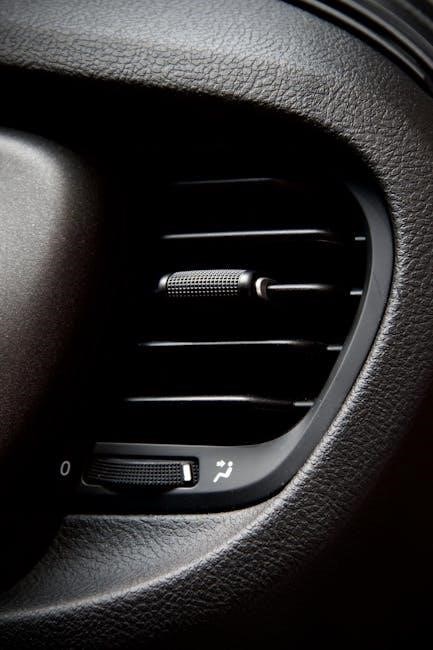The horizontal stabilizer trim system is crucial for aircraft pitch control and stability. Failures in this system can lead to significant safety risks, as seen in recent incidents. This analysis explores the root causes, detection methods, and prevention strategies to enhance aviation safety standards and ensure reliable system performance.
1.1. Overview of the Horizontal Stabilizer Trim System
The horizontal stabilizer trim system is a critical component of an aircraft’s flight control system, designed to maintain pitch stability and reduce pilot workload. It consists of trim tabs and actuators that adjust the stabilizer’s angle to optimize flight performance. The system operates manually or automatically, responding to pilot inputs or flight conditions. Modern systems integrate with fly-by-wire technology for precise control. Its primary function is to counteract aerodynamic forces, ensuring smooth transitions during climb, cruise, and descent. The system’s architecture includes sensors, motors, and control units, working in harmony to maintain aircraft equilibrium. Its reliability is essential for safe and efficient flight operations.
1.2. Importance of the Trim System in Aircraft Stability
The horizontal stabilizer trim system plays a pivotal role in maintaining aircraft stability and control during various flight phases. By adjusting the stabilizer’s angle, it counteracts aerodynamic forces, ensuring the aircraft remains balanced and responsive. Proper trim settings enable pilots to maintain desired altitude and airspeed with minimal control input, reducing fatigue. Additionally, the trim system compensates for weight distribution changes, such as fuel burn or cargo shifts, ensuring consistent handling. Its failure can lead to unpredictable pitch behavior, making manual control difficult. Thus, the trim system is vital for both performance and safety, directly impacting the aircraft’s ability to operate efficiently and safely under all conditions.

Understanding the Horizontal Stabilizer Trim System
The horizontal stabilizer trim system consists of mechanical and electronic components that adjust the stabilizer’s angle to optimize pitch control and reduce pilot workload during flight.
2.1; Components and Architecture of the Trim System
The horizontal stabilizer trim system comprises a trim wheel, electric motor, actuator, and control unit. These components work in tandem to adjust the stabilizer’s angle, ensuring optimal pitch control. The system’s architecture is a blend of mechanical and electronic elements, with inputs from sensors and pilot commands. The trim wheel allows manual adjustments, while the electric motor automates the process. The actuator translates these commands into physical movements of the stabilizer. This integrated design enables precise control, with fail-safes to prevent unintended movements. The system’s connectivity through wiring and sensors ensures real-time responsiveness to flight conditions and pilot inputs, maintaining aircraft stability and performance.
2.2. Function and Response to Auto/Manual Trim Commands
The trim system executes pitch control by adjusting the horizontal stabilizer’s angle in response to manual or autopilot commands. Manual adjustments involve the pilot turning the trim wheel, which directly moves the stabilizer. Auto-trim, activated by the autopilot or systems like MCAS, uses sensors to assess flight parameters and automatically adjusts the stabilizer for optimal performance. The system ensures smooth transitions between manual and auto modes, maintaining stability without pilot input. Real-time feedback mechanisms prevent over-correction, while fail-safes like cut-out switches allow pilots to regain control if anomalies occur. This dual functionality enhances both pilot workload reduction and aircraft responsiveness, critical for safe and efficient flight operations.

Failure Modes and Effects Analysis (FMEA)
FMEA systematically identifies potential failures in the trim system, evaluating their effects on aircraft performance. It ensures compliance with safety standards and regulatory requirements, minimizing risks and enhancing reliability.
3.1. Mechanical Failures in the Trim System
Mechanical failures in the horizontal stabilizer trim system often stem from faulty actuators, jack screws, or trim tabs. These components are critical for precise pitch control, and their malfunction can lead to unstable flight conditions. For instance, the failure of the threaded rod in the Cessna U206F trim tab actuator caused severe flutter, compromising aircraft stability. Similarly, issues with the stabilizer’s jack screw or actuator can result in uncommanded trim movements, as seen in the Boeing 737 MAX incidents. Such failures highlight the importance of robust mechanical design, regular maintenance, and adherence to safety protocols to prevent catastrophic outcomes.
3.2. Software-Related Failures in the Trim System
Software-related failures in the horizontal stabilizer trim system can lead to unintended trim adjustments, affecting aircraft control. The Boeing 737 MAX crashes highlighted issues with MCAS software, which repeatedly activated stabilizer trim based on faulty sensor data. Similarly, glitches in trim control algorithms or improper integration with other systems can cause erratic behavior; Such failures underscore the need for rigorous software testing, redundancy, and fail-safe mechanisms. Regular updates and pilot training are essential to mitigate risks associated with software malfunctions, ensuring reliable operation of the trim system during critical flight phases.

Case Studies of Horizontal Stabilizer Trim System Failures
The Lion Air and Ethiopian Airlines 737 MAX incidents highlighted MCAS-related trim system failures, while the Cessna U206F experienced mechanical failures leading to stabilizer malfunctions, underscoring critical safety risks.
4.1. Lion Air and Ethiopian Airlines 737 MAX Incidents
The Lion Air and Ethiopian Airlines 737 MAX incidents were tragic examples of horizontal stabilizer trim system failures. In both cases, the MCAS system repeatedly activated due to erroneous angle-of-attack sensor data, causing the stabilizer to trim nose-down. Pilots faced significant challenges in countering these unintended trim inputs, leading to loss of control and fatal accidents. These events highlighted critical issues with MCAS design, including its reliance on a single sensor and aggressive trim authority. The incidents prompted widespread scrutiny of aircraft certification processes, software design flaws, and pilot training programs, leading to significant changes in aviation safety practices globally.
4.2. Cessna U206F Tailplane Failure Incident
The Cessna U206F incident involved a catastrophic failure of the horizontal stabilizer shortly after takeoff. The failure occurred when the threaded rod end in the trim tab actuator failed, causing the trim tab to flutter. This led to a chain reaction, resulting in the failure of both the front and rear spars in the right-hand horizontal stabilizer. The incident underscored the critical role of mechanical integrity in trim systems. Despite investigations, the exact cause of the failure remained undetermined, highlighting the complexity of diagnosing such events. This case serves as a stark reminder of the potential consequences of mechanical failures in critical flight control systems.

Causes of Horizontal Stabilizer Trim System Failures
Causes include mechanical issues, such as actuator malfunctions, and software glitches, including erroneous control commands. These failures can stem from design flaws or maintenance oversights.
5.1. Mechanical Issues and Component Malfunctions
Mechanical failures in the horizontal stabilizer trim system often stem from component malfunctions, such as faulty actuators, jackscrews, or ball screws. These components are critical for transmitting trim commands to the stabilizer. Failures can occur due to wear and tear, manufacturing defects, or insufficient maintenance. For instance, the Cessna U206F incident highlighted how a failed trim tab actuator led to stabilizer damage. Similarly, the Boeing 737 MAX crashes revealed issues with the MCAS system’s interaction with the stabilizer trim, emphasizing the vulnerability of mechanical systems to design or operational flaws. Such failures can result in unpredictable aircraft behavior, making prompt identification and repair essential for safety.
5.2. Software Glitches and System Design Flaws
Software glitches and design flaws in the horizontal stabilizer trim system can lead to unintended trim actions, disrupting aircraft control. For example, the Boeing 737 MAX crashes highlighted issues with the MCAS system, where software relied on a single sensor, causing repeated nose-down trim commands. Similarly, faulty flight control algorithms can misinterpret data, leading to erroneous trim inputs. Design flaws, such as inadequate redundancy or insufficient pilot overrides, exacerbate these issues. These failures underscore the importance of rigorous software validation and system design robustness to prevent catastrophic outcomes. Addressing these flaws requires enhanced testing protocols and fail-safe mechanisms to ensure pilot control remains paramount during malfunctions.

Detection Methods for Trim System Failures
Real-time monitoring systems and diagnostic tools help detect trim system failures by identifying anomalies in performance. Pre-flight inspections and Failure Modes and Effects Analysis (FMEA) further ensure reliability.
6.1. Real-Time Monitoring and Diagnostic Tools
Real-time monitoring systems play a critical role in detecting horizontal stabilizer trim system failures. These systems utilize sensors to track the trim system’s performance during flight, enabling immediate detection of anomalies. Advanced diagnostic tools analyze data from these sensors, identifying potential issues such as mechanical malfunctions or software glitches. Pilots receive alerts for any deviations from normal operation, allowing proactive measures to maintain control. Additionally, these tools log data for post-flight analysis, aiding in root cause identification. The integration of real-time monitoring enhances safety by enabling timely interventions and minimizing the risk of catastrophic failures. Regular software updates ensure the system remains effective and reliable.
6.2. Pre-Flight and Post-Flight Inspection Procedures
Pre-flight inspections ensure the horizontal stabilizer trim system is functioning correctly. Pilots visually inspect the trim tabs and actuators for damage or malfunctions, while maintenance crews check for software updates. Post-flight inspections involve reviewing flight data for anomalies and performing physical checks to identify wear. These procedures help detect issues early, preventing potential failures during subsequent flights. Regular inspections also ensure compliance with safety regulations, maintaining aircraft airworthiness and reducing risks. By systematically evaluating the trim system, these procedures enhance overall flight safety and reliability. They are integral to preventing failures and ensuring optimal performance. Consistent adherence to these protocols is essential.

Consequences of Horizontal Stabilizer Trim System Failures
Failures can lead to loss of pitch control, making the aircraft difficult to stabilize. This can result in accidents, injuries, or fatalities, emphasizing the critical need for reliable systems.
7.1. Impact on Aircraft Performance and Control
A failure of the horizontal stabilizer trim system can significantly degrade aircraft performance and control. The loss of trim functionality makes it difficult for pilots to maintain desired pitch attitudes, increasing workload. This can lead to unstable flight characteristics, such as oscillations or divergence from intended altitude. Additionally, without proper trim, the aircraft may require constant manual input, reducing efficiency and increasing fuel consumption. In extreme cases, uncontrolled pitch movements can compromise safety, making the aircraft harder to recover and increasing the risk of accidents. Such failures underscore the critical role of the trim system in maintaining optimal flight dynamics and pilot authority.
7.2. Safety Implications and Potential Accidents
Failures in the horizontal stabilizer trim system pose severe safety risks, potentially leading to loss of aircraft control. Such failures can result in uncommanded pitch movements, making recovery difficult for pilots. Historical incidents, like the Lion Air and Ethiopian Airlines 737 MAX crashes, highlight how trim system malfunctions can escalate into catastrophic accidents. These events underscore the critical need for robust fail-safes and pilot training to mitigate such risks. The consequences of trim system failures extend beyond operational challenges, directly impacting passenger and crew safety. Addressing these issues is paramount to preventing future accidents and ensuring the integrity of flight control systems.

Prevention Strategies and Maintenance Practices
Regular inspections, component testing, and adherence to manufacturer guidelines are essential to prevent trim system failures. Implementing software updates and conducting routine maintenance ensures system reliability and safety.
8.1. Regular Maintenance and Inspection Schedules
Regular maintenance and inspection of the horizontal stabilizer trim system are critical to prevent failures. This includes lubrication of mechanical components, software updates, and thorough checks of actuators and sensors. Technicians must follow detailed schedules to ensure all parts function optimally. Real-time monitoring tools can detect early signs of wear or malfunction, enabling proactive repairs. Adhering to these practices minimizes the risk of mechanical and software-related issues, ensuring the system operates reliably under various flight conditions. Compliance with manufacturer guidelines and regulatory standards is essential to maintain safety and performance. Consistent upkeep also reduces the likelihood of unexpected failures during critical phases of flight.
8.2. Upgrades and Modifications to the Trim System
Upgrades and modifications to the horizontal stabilizer trim system are essential to enhance reliability and safety. These include software updates for improved auto-trim functionality and hardware reinforcements to prevent mechanical failures. For instance, Boeing implemented MCAS software fixes on the 737 MAX to address trim-related issues. Additionally, integrating advanced sensors and redundancy systems can mitigate potential malfunctions. Regular updates ensure compliance with evolving aviation standards. Modifications such as replacing outdated actuators or introducing fail-safe mechanisms further reduce failure risks. These improvements not only address historical failure modes but also adapt to emerging technologies, ensuring safer and more efficient flight operations. Proactive upgrades are vital for maintaining system integrity and passenger safety.

Pilot Training and Response to Trim System Failures
Pilot training is critical for effectively managing horizontal stabilizer trim system failures. Programs emphasize emergency procedures, simulation exercises, and real-time scenario practice to ensure safe outcomes during malfunctions.
9.1. Emergency Procedures for Trim System Failures
Effective emergency procedures for horizontal stabilizer trim system failures involve immediate pilot action to regain aircraft control. Pilots should disconnect autopilot and auto-throttle systems, then manually adjust the trim wheel to counteract unwanted pitch movements. In cases of runaway trim, such as those observed in the 737 MAX incidents, pilots must follow established runaway trim recovery procedures, which include disengaging the stabilizer trim motor and using manual trim to stabilize the aircraft. Training emphasizes maintaining situational awareness and applying correct control inputs to prevent further destabilization. Post-failure, pilots should perform a thorough systems check and communicate with air traffic control to ensure safe continuation of the flight. These steps are critical to mitigating risks and preventing accidents.
9.2. Simulation Training for Critical Situations
Simulation training is essential for preparing pilots to handle horizontal stabilizer trim system failures effectively. Advanced flight simulators replicate real-world scenarios, such as runaway trim or system malfunctions, allowing pilots to practice recovery techniques in a controlled environment. These sessions focus on developing muscle memory for manual trim operations and improving decision-making under stress. Training programs incorporate case studies, like the Lion Air and Ethiopian Airlines incidents, to emphasize proper procedures. Pilots learn to recognize failure indicators, disconnect automatic systems, and maintain aircraft stability manually. Regular simulation exercises ensure that pilots are proficient in managing trim system failures, thereby enhancing overall flight safety and reducing accident risks significantly.

Long-Term Implications and Future Developments
Future advancements in trim system technology, including AI-driven monitoring and redundant designs, will enhance safety and reliability, minimizing risks of catastrophic failures and improving pilot response capabilities.
10.1. Advances in Trim System Technology
Recent advancements in trim system technology focus on integrating AI-driven monitoring and predictive maintenance tools. These systems analyze real-time data to detect potential failures early, ensuring proactive maintenance. Additionally, the development of more robust and redundant components, such as dual-sensor systems and fail-safe actuators, enhances reliability. The use of advanced materials and smart systems reduces mechanical wear and tear, while automation improves response times during critical situations. These innovations aim to minimize human error and enhance overall system resilience, paving the way for safer and more efficient flight operations in the future.
10.2. Regulatory Changes and Safety Enhancements
Recent regulatory changes have mandated stricter safety protocols for trim systems, emphasizing fail-safe designs and enhanced monitoring. Authorities like the FAA and EASA now require real-time system health checks and redundant safety measures. Post-737 MAX incidents, certification processes have been tightened, ensuring systems like MCAS undergo rigorous testing. Mandatory pilot training programs focus on trim system malfunctions, improving response capabilities. These changes aim to prevent catastrophic failures and enhance overall aviation safety. Ongoing collaboration between regulators, manufacturers, and airlines ensures continuous improvement in safety standards and oversight.
The analysis highlights critical aspects of horizontal stabilizer trim system failures, emphasizing safety, design improvements, and regulatory oversight. Future advancements must prioritize robust systems and pilot training to ensure aviation safety and reliability.
11.1. Summary of Key Findings
The analysis identifies mechanical and software-related failures as primary contributors to horizontal stabilizer trim system malfunctions. High-profile incidents, such as the 737 MAX crashes, underscore the critical role of system design and pilot training. Root causes include component wear, software glitches, and inadequate safety protocols. Real-time monitoring and robust maintenance practices are essential for early detection and prevention. Enhancing system redundancy and adherence to regulatory standards can mitigate risks. Pilot training must emphasize emergency procedures to address trim system failures effectively. These findings underscore the need for a holistic approach to ensure aircraft stability and safety, prioritizing both technological advancements and human factors.
11.2. Recommendations for Future Safety Practices
To enhance safety, it is crucial to implement robust fail-safe mechanisms in trim systems, ensuring redundancy and eliminating single-point failures. Regular, detailed inspections and maintenance schedules should be enforced to identify potential issues early. Upgrading software and hardware to address design flaws and improve system reliability is essential. Pilot training programs must emphasize emergency procedures for trim system failures, incorporating realistic simulations. Regulatory bodies should enforce stricter certification standards and continuous oversight of system performance. Collaboration between manufacturers, airlines, and safety agencies is vital to share data and best practices. These measures will significantly reduce the risk of accidents linked to stabilizer trim system failures.
